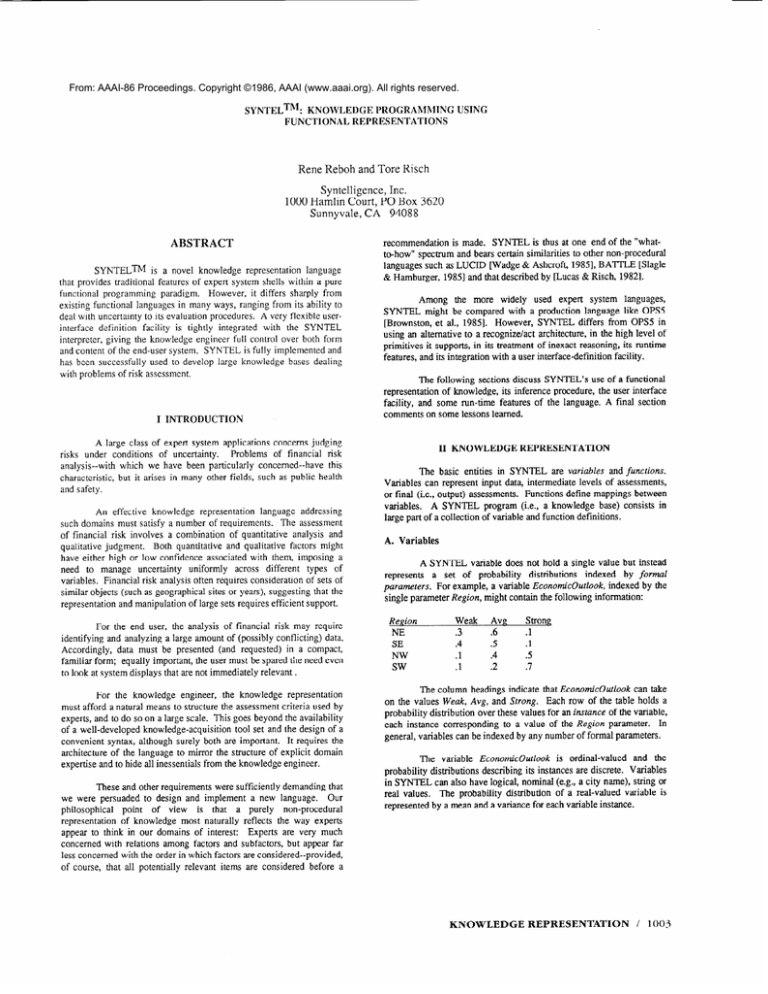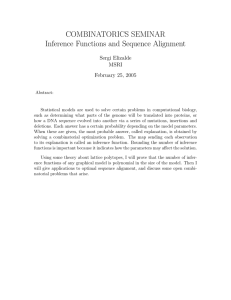
From: AAAI-86 Proceedings. Copyright ©1986, AAAI (www.aaai.org). All rights reserved.
SYNTELTM:
KNOWLEDGE
PROGRARlhlING
FUNCTIONAL REPRESENTATIONS
USING
Rene Reboh and Tore Risch
Syntelligence, Inc.
1000 Hamlin Court, PO Box 3620
Sunnyvale, CA 94088
ABSTRACT
SYNTELTM is a novel knowledge representation language
that provides traditional features of expert system shells within a pure
functional programming paradigm.
However, it differs sharply from
existing functional languages in many ways, ranging from its ability to
deal with uncertainty to its evaluation procedures. A very flexible userinterface definition facility is tightly integrated with the SYNTEL
interpreter, giving the knowledge engineer full control over both form
and content of the end-user system. SYNTEL is fully implemented and
has been successfully used to develop large knowledge bases dealing
with problems of risk assessment.
I INTRODUCTION
A large class of expert system applications concerns judging
risks under conditions of uncertainty.
Problems of financial risk
analysis--with which we have been particularly concerned--have
this
characteristic, but it arises in many other fields, such as public health
and safety.
An effective knowledge representation language addressing
such domains must satisfy a number of requirements.
The assessment
of financial risk involves a combination of quantitative analysis and
Both quantitative and qualitative factors might
qualitative judgment.
have either high or low confidence associated with them, imposing a
need to manage uncertainty
uniformly across different types of
variables. Financial risk analysis often requires consideration of sets of
similar objects (such as geographical sites or years), suggesting that the
representation and manipulation of large sets requires efficient support.
For the end user, the analysis of financial risk may require
identifying and analyzing a large amount of (possibly conflicting) data.
Accordingly, data must be presented (and requested) in a compact,
familiar form; equally important, the user must be spared the need even
to look at system displays that are not immediately relevant .
For the knowledge engineer, the knowledge representation
must afford a natural means to structure the assessment criteria used by
experts, and to do so on a large scale. This goes beyond the availability
of a well-developed knowledge-acquisition
tool set and the design of a
convenient syntax, although surely both are important. It requires the
architecture of the language to mirror the structure of explicit domain
expertise and to hide all inessentials from the knowledge engineer.
These and other requirements were sufficiently demanding that
we were persuaded to design and implement a new language.
Our
philosophical
point of view is that a purely non-procedural
representation of knowledge most naturally reflects the way experts
appear to think in our domains of interest: Experts are very much
concerned with relations among factors and subfactors, but appear far
less concerned with the order in which factors are considered--provided,
of course, that all potentially relevant items are considered before a
recommendation is made. SYNTEL is thus at one end of the “whatto-how” spectrum and bears certain similarities to other non-procedural
languages such as LUCID IWadge & Ashcroft, 19851, BATTLE [Slagle
& Hamburger, 19851 and that described by CLucas & Risch, 19821.
Among the more widely used expert system languages,
SYNTEL might be compared with a production language like OPS5
[Brownston, et al., 19851. However, SYNTEL differs from OPS5 in
using an alternative to a recognize/act architecture, in the high level of
primitives it supports, in its treatment of inexact reasoning, its runtime
features, and its integration with a user interface-definition facility.
The following sections discuss SYNTEL’s use of a functional
representation of knowledge, its inference procedure, the user interface
facility, and some run-time features of the language, A final section
comments on some lessons learned.
II KNOWLEDGE
REPRESENTATION
The basic entities in SYNTEL are variables and functions.
Variables can represent input data, intermediate levels of assessments,
or final (i.e., output) assessments. Functions define mappings between
variables.
A SYNTEL program (i.e., a knowledge base) consists in
large part of a collection of variable and function definitions.
A. Variables
A SYNTEL variable does not hold a single value but instead
represents
a set of probability
distributions
indexed by formal
parameters. For example, a variable EconomicOutlook, indexed by the
single parameter Region, might contain the following information:
Re 2 ion
NE
SE
SW
Weak
.3
.4
.l
.l
Avg
.6
.5
.4
.2
Strong
.l
.l
.5
.7
The column headings indicate that EconomicOutlook can take
on the values Weak, Avg, and Strong. Each row of the table holds a
probability distribution over these values for an instance of the variable,
each instance corresponding to a value of the Region parameter.
In
general, variables can be indexed by any number of formal parameters.
The variable EconomicOutlook is ordinal-valued
and the
probability distributions describing its instances are discrete. Variables
in SYNTEL can also have logical, nominal (e.g., a city name), string or
real values. The probability distribution of a real-valued variable is
represented by a mean and a variance for each variable instance.
KNOWLEDGE
REPRESENTATION
/
1003
Because uncertainty, in various guises, plays such an important
role in financial assessment problems, we have provided additional
For example, variables and
mechanisms
for its representation.
parameters can both have Unknown as an explicit value, with
An unknown parameter
consequences that are context dependent.
causes the creation of a partially-indexed
set, an unknown logical
Other
variable is treated using a 3-valued logic, and so forth.
mechanisms for managing uncertainty include support of prior and
default probability distributions over variables.
Our interest in the efficiency of the knowledge engineering
process, together with our desire for extensive error checking facilities,
has led us to develop a powerful type system. The language has a
handful of built-in variable types, but a typical knowledge base contains
many times that number of additional variable types defined by the
knowledge engineer. This extensive use of typing leads to code-sharing
(further enhanced by an inheritance hierarchy of types), and to improved
consistency of large knowledge bases. Control of errors is facilitated by
compile-time and run-time type-checking.
B. Functional Representations
We have made a strong commitment
to knowledge
representation based on functional mappings between variables.
To
describe this approach by example, suppose a real-valued variable
Population, indexed by Region, is to be combined with our previouslydefined EconomicOutlook to estimate the size of a target market of
interest. This would be represented by
TargetMarkzt(Region) <=
f[EconomicOutlook(Region),
Population(Region)].
The knowledge engineer is not free to define the function f
arbitrarily. Rather, he or she selects the computational form off from
among the several dozen supported in SYNTEL.
Accordingly, this
selection process--and, for some functions, specification of additional
information like weighting factors--plays a central role in the lmowledge
engineering process.
The functional
forms supported
by SYNTEL,
called
CompurationTypes, fall naturally into several families.
Beyond the
expected arithmetic and logical functions, there are important families
of functions for performing a variety of tests and manipulations on sets,
for combining or weighting variables in several ways, for testing the
current state of the computation, and for accessing databases.
Certain ComputationTypes have the important ability to
The
combine arguments of different modalities probabilistically.
simplest such, Table, illustrates the principle.
To use it to compute
TargetMarket, a table such as the following would be defined, which
would apply to each Region.
TargetMarket
Population
O-40
40 - 50
50-+INF
EconomicOutlook
Weak
Avg
Strong,
10
15
15
The table extensionally
how an ordinal and a real-valued
real variable TargetMarket.
1004
/ ENGINEERING
20
25
35
25
30
45
represents the expert’s judgment of
variable are combined to estimate the
Suppose there were uncertainty in the arguments because each
is an estimate of the value, say, in the year 1995. Then each argument
would have an associated
probability
distribution,
discrete for
EconomicOutlook and normal for Population. Integration of the normal
over the indicated ranges, together with an assumption of independence,
allows the mean and variance of TargetMarket to be computed.
While simple tables are useful, judgments of this sort are
usually combined using a more complex ComputationType, called
Weight, that implements a non-linear, probabilistic voting scheme.
Weight uses a mechanism analogous to Table, in combination with
summation and a “soft” threshold, to map between variables of arbitrary
modalities.
With the intense current interest in methods for managing
inexactness in expert systems [e.g., Pearl, 1985; Heckerman,
1985;
Zadeh, 1985; Gordon & Shortliffe, 19851, it may seem foolhardy to
have designed and implemented
an alternative representation
for
experts’ subjective beliefs. Nonetheless, the “rate and weight” style of
reasoning we found prevalent in financial institutions led us to develop
the Weight mechanism which, extending earlier work Duda and Reboh,
1984; Reboh, Reiter and Gashnig, 19821, eases the problem of
representing the “apples to oranges” comparisons that are an essential
part of financial risk assessment.
Even a cursory description of the remaining ComputationTypes
would far exceed space limitations, but we make a few general
Every function works with probability distributions as
comments.
inputs; independence of arguments is assumed as needed. Distributions
are typed; e.g., normal, discrete, exact, or undefined. However, unlike
the strong typing of variables, distribution types can be determined only
All probabilistic
calculations converge smoothly to
at run-time.
deterministic calculations when a variable is bown with certainty.
Each argument to a function can be a set (of distributions), so it
is important to support set manipulations within argument definitions.
We have therefore provided
means for selecting,
aggregating,
disaggregating, and defaulting variable instances. A simple example of
this is the selection of the Maximumlnstance of a variable.
In the
illustration above, this could be used to identify the Region having the
largest TargetMarket.
Continuing the illustration, we can easily imagine an expert
specifying EconomicOutlook to depend on a variety of additional
quantitative and qualitative variables. One or more additional equations
would therefore have to be written to define EconomicOutlook and its
arguments until a primitive input level was reached. Mathematically,
the principal operation for articulating a knowledge base is thus function
composition. The computational correlate of this is function evaluation,
which will be further described below.
Before moving on, though, we should re-emphasize the purely
declarative nature of this representation.
The “<=” signifies function
definition, not assignment; the right hand side of the equation contains
no assignments, deletions, or other side effects. Thus, the order of
function evaluation is controlled entirely by the SYNTEL interpreter,
not by the knowledge engineer.
This separation is more than a
theoretical nicety. In practice, the knowledge engineer is not concerned
with control issues. (See [Schor, 19861 for a further discussion of this
point.)
III INFERENCE
A single inference step in SYNTEL consists of the side-effectfree evaluation of a function, given the value of its arguments.
This
step, called propagation, takes place whenever the value of an argument
to any function is changed. If the function being evaluated is itself an
argument of a second function, a subsequent evaluation will be
performed. The basic evaluation strategy is thus forward chaining, and
the result of an inference cycle is to maintain the values of functions
consistent with the (new) values of their arguments.* Propagation is the
central operation of SYNTEL’s inference engine.
A. Inference Networks
The nesting of function compositions is compiled into an
explicit data structure called the static knowledge base. The static
knowledge base can be represented as a directed acyclic graph in which
nodes correspond to functions and arcs point to a function from its
We call these graphs inference nets, following the
arguments.
terminology established in the PROSPECTOR system for analogous but
Nodes with no incoming arcs represent special
simpler structures.
elementary functions that accept input data from the user or from
external data sources. Nodes with no outgoing arcs represent “toplevel” functions whose values are among those displayed to the user.
A typical cycle of operation begins with the user providing a
new value for any node in the inference net to which he or she has
access. (Access mechanisms are described in the following section.)
Subsequent function evaluations can be visualized as a dataflow
originating at the changed node and propagating upwards along the arcs
of the inference net.
Changing the value of a node cannot lead to the creation of
new variables-- i.e., of new nodes. However, it can lead to the creation
or deletion of instances of existing variables. When this occurs, a truth
maintenance procedure (adapted to our functional representation) is
invoked to assure global consistency over all instances of all variables.
B. Efficiency Issues
A typical knowledge base written in SYNTEL contains
thousands of nodes and, since functions in general compute sets of
distributions, many thousands of instances.
We have therefore been
motivated to develop several techniques to enhance propagation
efficiency. Together, they implement the strategy “Compute only what
you must, and that only once.”
Non-redundant computation:
Because an inference net is a
graph rather than a tree, because instances of a node can be selected by
other nodes, and because propagation can be initiated from several
nodes simultaneously,
a straightforward
propagation
algorithm will
perform unnecessary recomputation of functions.
Limited propagation
and non-redundant
computation
are
supported by an extensive compile-time analysis of the static knowledge
base. The analysis identifies the connections between each node in the
inference net and each screen that the user may see. It also produces an
optimal partial ordering for function evaluation.
In these and similar
optirnizations we have favored run-time efficiency at the expense of
compilation cost.
IV USER INTERFACE
It is widely recognized that the user interface consumes a large
proportion of application development resources, yet its design is so
critical to system acceptance that its development cannot be slighted.
Our approach to this ubiquitous problem is to separate the description of
the interface cleanly into two parts: one governing the appearance and
interactive
itself,
and the other
defining
the
inference
Our application domains make it natural to adopt the business
form as the underlying display metaphor, much as ONCOCIN [Hickam,
et al., 19851 uses medical forms for its domain. Examples of business
forms are insurance applications or sets of financial statements. Figure
1 shows a form concerning the assessment of a building’s fire risk.
WILDING
ncation
nlmber:
Building
Actequate
FIRE
RISK -
CDNSTRlJCTION -
FIRE
i
ALLIED
Ii
age:
for current
occupancy:
Heating
condition
ssseaslllent:
Electrical
capacity
assent:
Aluinm
or other
inferior
wiring:
Tmprary
wiring
asseszaent:
Electrical
cmditron:
Heating
CmstructiM
and ala
type:
CMcaaled
spaces:
Interior
finishing:
Mixed cm5tructlM:
Admquacy of cutoffs:
kdmr
*But see Section V for a description of a backward chaining sub-process.
of the display
between display objects and the underlying
A. Display Description
Updated instances:
Function values are computed only for
those instances of its arguments that have changed significantly.
Referring to our earlier example, if our economist tells us that the
EconomicOutlook for the NorthEast region has improved, we would
compute a new value for only the variable instance TargetMarket(
Limited Propagation: New function values are computed only
if they affect the display seen by the user. A change in the value of any
node may, in general, affect the values of many output nodes, only some
of which can be displayed at any one time. By limiting propagation to
these visible nodes, execution time is proportional to the number of
outputs displayed rather than to the total size of the knowledge base.
Potential changes to other nodes are recorded in a queue if needed.
properties
logical relations
net.
or
stories:
a,
Construction
Building
Figure
fire
risk
assessnmnt
fire
risk
amesant
1: Fire risk at Location
1
Forms are represented as structured objects constructed of
rectangular primitive regions called boxes and non-primitives called
groups. Boxes (which need not have visible outlines) are used to accept
input data, display several kinds of output assessments, and allocate
regions for displaying text and annotations of various kinds. Groups,
which can be nested to any depth, are typically used to define larger
regions of the display, to define a single full display screen (a “form”)
z?d to define sets of forms.
KNOWLEDGE
REPRESENTATION
/
1005
A high-level form description language provides the means for
defining and positioning boxes, for composing them into higher-level
groups, and for associating various properties with them.
These
descriptions can be compiled to run on desired target displays.
The user-interface definition-facility has allowed us to factor
knowledge base design into two independent parts. The inference net is
based on decision criteria supplied by experts, while the interface is
governed by the need to provide a smooth, natural and efficient
environment for the end user.
B. Inference Net Integration
between
inference
variables
the more
An important design feature of SYNTEL is the close relation
the user interface and the control of propagation
in the
net. Control is accomplished through explicit links between
held in nodes of the inference net and display objects. Among
important links are the following:
Input data: A link can specify a node which is to receive a
user-supplied value. When a user enters a value for a variable (typically
by menu-selection), the forward-propagation
process is initiated. Since
any variable can be selected, the underlying flow of control is
effectively in the hands of the user*.
Output and Limited Propagation
: A node value can be
displayed (in any of several formats) in a linked object, and is updated
whenever a change occurs. As mentioned earlier, propagation does not
proceed “upward” beyond currently-displayed
objects.
Conditional display: In our domains of interest, the complete
assessment of a single case can in principle require the user to supply a
very large number of individual data items. In practice, fortunately,
most cases can be resolved after supplying only a small subset of the
possibly-relevant
data. A forward-chaining
system, however, cannot
easily take advantage of this opportunity to spare the user from the need
to supply values for, or even to scan, unnecessary items.
Our design approach to this difficulty has been to hide from the
user all information or requests for data whose present relevance is
problematic. We accomplish this by allowing the display of any object
to be conditional on the value of any logical variable. Figure 2 shows
the Fire Risk form as it applies to Location 2. The input data requested
for this building is rather different from that shown in Figure 1, because
the two buildings differ in key aspects such as age, height and
construction-type.
Thus, while the user controls the flow of inferences,
this control can be exercised only within currently-relevant
portions of
the knowledge base.
lumber:
12
@uilding age:
Adtlqlnts for current occupancy:
Heating
i
i
and electrical
*ssessma"t
fT"T:.,;:
.II(.,
CAPABILITIES
The SYNTEL run-time environment contains a number of
features to increase the efficiency and confidence of the end user. For
reasons of space, we describe just two of them: the backward chaining
facility and the explanation facility.
A. Backward Chaining
While we believe that the user should control the interaction,
we have nonetheless found it important to indicate which missing data
items are especially relevant in the current context. To this end, we
have designed a best-first search algorithm based on sensitivity analysis.
Working backwards from an identified goal node, the algorithm uses the
probability distribution at each daughter node to estimate the amount by
which that daughter is likely to change the distribution of the parent.
The process continues until input nodes are reached. The input node
having the largest likelihood of changing the goal node is indicated to
the user, who ‘is free to accept the advice or to supply some other piece
of data.
B. Explanations
The ability to explain reasoning is an important feature of
expert systems, improving both the efficiency of knowledge engineering
and the acceptability by users. However, as representational power has
grown beyond that of the earliest systems, it has become increasingly
difficult to generate cogent explanations.
Because we wish to minimize the need for knowledge
engineers to define significant auxiliary structures, we have had to rule
out approaches like those described by [Neches, et al., 19851 and
[Smith, et al,, 19851. Instead, we adopted a simpler approach based on
refining the standard notion of the support for an inference.
In a functional representation such as ours, the support for a
variable is simply the arguments of the function that computes its value.
We extend this slightly and define explainable support to be a subset of
the support so designated by the knowledge engineer. Explanations can
be then restricted to include only those variables whose meanings are
judged to be intuitive and useful to the end user.**
A recursive
procedure allows the user to explore explainable supports to any desired
depth.
BUILDINGFIRE RISK - CONS7RUCTION
- FIRE L ALLIED
LoutiM
V RUN-TIME
;+I
cmstruction
type:
conwaled
spaces:
Intarlor
flnishlng:
VI STATUS AND CONCLUSIONS
Yurber Of stLlr1es:
ml
AdequA3ly 7Aned heat/air:
Flmr openings ws-nt:
DetectIon equipant assmnt:
Elevator safety sss-nt:
Epsrgency backw p-r:
Ccmstructicm fire
Buildlng fire
SYNTEL has been implemented on a Xerox 1 lxx in InterlispD and in a distributed IBM mainframe/workstation
environment in PUI
and C. Several large knowledge bases have been built, with the aid of a
well-developed knowledge engineering environment, to address risk
assessment problems in commercial insurance and banking.
risk assesaaent
risk
assessment
What has been learned?
Figure 2: Fire risk at Location 2
**Even
*This is analogousto the use
[Stefik, et al.,
of active values in access-oriented
programming
19861. In SYNTEL, however, function evaluation is invoked
the system,rather than by programmer-providedexplicittriggers.
1006
/ ENGINEERING
systems
uniformly
by
though a
SYNTEL knowledge base contains no control information-a
problem for explanation
systems--the
representunintuitiveconcepts.
standard
expert may judge some intermediate variables to
The salient feature of SYNTEL is its functional representation
of knowledge.
Even experienced computer scientists and software
engineers require a little time before they are fully comfortable with this
purely
non-procedural
representation.
Significantly,
however,
computer-naive domain experts find it very natural to describe their
expertise in these terms. This suggests that we have at least partially
achieved our goal of matching the representation to the structure of
domain knowledge. This conclusion is further supported by the fact that
no knowledge base built to date has had to escape to the underlying
implementation language.
We have come to appreciate the benefits to the user of a “soft”
mixed-initiative system. Forward chaining provides the basis for highbandwidth, user-controlled interactions.
The features for computing
advice and conditionally controlling the display prevent the interactions
from becoming unfocused and time-wasting.
A final point: We have tenaciously maintained the purity of
the non-procedural architecture, with consequences extending beyond
philosophical gratification.
It has allowed the system to undergo major
enhancements with minimum re-coding.
ACKNOWLEDGEMENTS
SYNTEL has benefited greatly from the work and ideas of
many people. We especially wish to acknowledge the contributions of
A. Barzilay, R. 0. Duda, S. Gower, J. Harris, P. E. Hart, M. Ljungberg,
J. Reiter, J. F. Rulifson, and A. White. We also thank D. Bobrow, A.
Schiffman and J. Aikens for their constructive comments on earlier
versions of this paper.
and Moore, J., “Explainable
(and
Neches, R., W.R. Swartout,
Maintainable) Expert Systems,” Proc. Ninth International Joint
Conference on Artificial Intelligence, (Los Angeles, 18-23 August
1985).
Pearl, J., “How to Do with Probabilities What People Say You Can’t,”
Proc. Second Conference on Artificial Intelligence Applications,
IEEE Computer Society, (Miami Beach, 11-13 December, 1985).
Reboh, R., J. Reiter and J. Gashnig, “Development of a KnowledgeBased Interface to a Hydrological
Simulation Program”, Final
Report, SRI Project 3477, (May 1982).
Better than
Schor, M.I., “Declarative Knowledge Programming:
Procedural?,” IEEE Expert, I (I), (Spring 1986).
Slagle, J. R., and H. Hamburger, “An Expert System for a Resource
Allocation Problem,” Cornm. ACM, 28 (9), (September, 1985).
Smith, R., H.A. Winston, T.M. Mitchell, and B.G. Buchanan,
“Representation and Use of Explicit Justifications for Knowledge
Base Refinement,” Proc. Ninth International Joint Conference on
Artificial Intelligence, (Los Angeles, 18-23 August 1985).
Stefik, M. J., D. G. Bobrow, and K. M. Kahn, “Integrating AccessOriented Programming into a Multiparadigm Environment,” IEEE
Software, 3 (IO), (January, 1986).
Wadge, W. W. and E. A. Ashcroft, Lucid, the Dataflow Programming
Language, Academic Press, 1985.
Zadeh, L., “Syllogistic Reasoning as a Basis for Combination of
Evidence in Expert Systems,” Proc. Ninth International Joint
Conference on Artificial Intelligence, (Los Angeles, 18-23 August
1985).
REFERENCES
Brownston, L., R. Farrell, E. Kant, and N. Martin, Progrumming Expert
Systems in OPS5, Addison-Wesley, 1985.
Duda, R. 0. and R. Reboh, “AI and Decision Making:
The
PROSPECTOR
Experience,”
in W. Reitman, Ed., Artificial
Intelligence Applications for Business, pp 11 l- 147,(Ablex
Publishing, Norwood, NJ, 1984).
Gordon, J., and E. H. Shortliffe, “A Method of Managing Evidential
Reasoning
in a Hierarchical
Hypothesis
Space,” Artificial
Intelligence, 26 (3), pp 323-358, (July, 1985).
Heckerman, D., “Probabilistic Interpretations of MYCIN’s Certainty
Factors,” Proc. Workshop on Uncertainfy and Probability in
Artificial Intelligence, (UCLA, 14-16 August, 1985).
Hickam, D.H., E. H. Shortliffe, M. B. Bischoff, A. Carlisle Scott, and C.
D. Jacobs, “The Treatment Advice of a Computer-Based Cancer
Chemotherapy Protocol Advisor,” Annals of Internal Medicine
103 (6), (December 1985).
Lucas, P. and T. Risch, “Representation of Factual Information by
Equations and Their Evaluation,” Sixth International Conference
on Sofhvare Engineering, (Tokyo, 13-16 September 1982).
.
KNOWLEDGE
REPRESENTATION
/
1007





